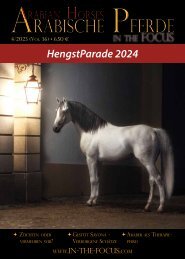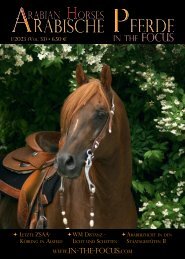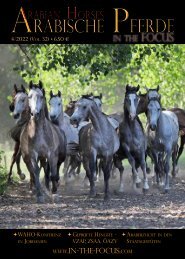Arabische Pferde IN THE FOCUS Nr. 3-2020 (Vol. 23) - public
Zeitschrift für Liebhaber und Züchter arabischer Pferde
Zeitschrift für Liebhaber und Züchter arabischer Pferde
Sie wollen auch ein ePaper? Erhöhen Sie die Reichweite Ihrer Titel.
YUMPU macht aus Druck-PDFs automatisch weboptimierte ePaper, die Google liebt.
By the late eighteenth century, there was a<br />
well-established tradition of horse breeding<br />
amongst the aristocratic families<br />
in Poland, these horses having a high proportion<br />
of Oriental blood. Turkoman, Persian and<br />
Arabian horses could be found at many of the<br />
studs, usually stallions, sometimes purchased<br />
by agents sent to the Ottoman Empire in search<br />
of superior bloodstock, sometimes received as<br />
gifts from the Ottomans, or from the Shahs of<br />
Safavid Persia, who were on friendly terms with<br />
Poland-Lithuania (an aristocratic re<strong>public</strong> existing<br />
from 1569 to 1795), as both were enemies<br />
of the Ottoman Empire.<br />
The Three Major Studs<br />
The first of the studs relevant to the history of<br />
the Polish Arabian is that of the Branicki family,<br />
whose seat was at Biała Cerkiew, located in<br />
current-day Ukraine. Their breeding farm was<br />
established at Szamrajówka in 1778, with foundation<br />
stock - two stallions and thirty mares -<br />
purchased from Stanisław Szczęsny Potocki’s<br />
Tulczyn Stud, and supplemented by local Polish<br />
mares of unknown parentage but definitely of<br />
Arabian type. The Tulczyn stallions may have<br />
been purebred Arabians; the mares, again of<br />
unknown parentage, would have been at the<br />
very least high percentage Oriental. Their studbook<br />
was created somewhat later - some sources<br />
say as early as 1803, others 1812, when the<br />
Uzin farm was established.<br />
Perhaps better known these days than the Branicki<br />
horses are those of the Sanguszkos. Hieronim<br />
inherited Sławuta from his half-brother<br />
Janusz in 1753, when he partitioned his estates<br />
between family and friends, but it was not until<br />
1791 that Hieronim founded the stud. The great<br />
Polish studs are generally known by the name<br />
of the family estate, but the horses themselves<br />
were kept at a variety of farms. So Sławuta is<br />
both an umbrella term for the Sanguszko breeding<br />
operation and also the name of the family<br />
home, where only a handful of horses would<br />
typically be kept. The main breeding operation<br />
was at Chrestówka: the 1799 stud report mentions<br />
that there were 243 horses there, including<br />
four stallions, forty-four mares with foals<br />
at foot, and eighty-three colts and fillies, whilst<br />
at Sławuta itself, there were forty-five horses,<br />
most of them stallions and geldings. In addition<br />
to Chrestówka there were two other farms<br />
at which horses were kept, though by the late<br />
nineteenth century the Sanguszko breeding<br />
operation had expanded, establishing the studs<br />
at Antoniny and Gumniska. A similar structure<br />
was in place for Białocerkiew and its subsidiary<br />
farms, Szamrajówka, Uzin and Janiszówka.<br />
Both the Branicki and the Sanguszko studs<br />
made use of a variety of breeds in the early days;<br />
the Arabian focus was a later development. In<br />
1790, the stallions owned by the Sanguszkos included<br />
a grey Neapolitan horse, and a big Turkish<br />
stallion. In the 1799 stud report, mention is<br />
made of a bay Persian stallion, a white Egyptian<br />
stallion, and a chestnut English stallion; they<br />
also had Cossack stallions. Twelve of the foals<br />
that year were sired by an English horse; only<br />
six by the bay Persian. Nonetheless, forty years<br />
3/<strong>2020</strong> - www.in-the-focus.com<br />
later, Hieronim’s grandson Władysław, owner<br />
of the Gumniska stud, wrote that the best race<br />
of horse to breed was Arabian, especially since<br />
Polish mares did not cross as well with other<br />
stallions, as they had such a high proportion of<br />
Arabian blood themselves.<br />
Prince Roman E. Sanguszko, owner of Slawuta<br />
Stud from 1844 onwards. - Prinz Roman E.<br />
Sanguszko, Besitzer des Gestüts Slawuta ab<br />
1844.<br />
In 1803, Hieronim sent an expedition under<br />
his equerry Kajetan Burski to the Middle East,<br />
seeking genuine desertbred Arab horses for<br />
the Sławuta stud. The results were five stallions<br />
and perhaps one precious mare; one of the stallions<br />
was sold to Count Branicki, and two of the<br />
others to Wacław Rzewuski. The stallions proved<br />
to be good sires, and so a pattern was established,<br />
whereby the aristocratic breeders sent<br />
expeditions to the Middle East to bring back<br />
desertbred Arab horses, stallions and - whenever<br />
possible - mares.<br />
Expeditions to the Desert<br />
In 1816, Hieronim’s son Eustachy Erazm sent<br />
another expedition to Aleppo, which returned<br />
in 1818 with nine stallions and one mare, a<br />
chestnut Saqlawiyah named Seglavia. Among<br />
the stallions was a pale grey Kuhaylan, named<br />
Hajlan, who sired the beautiful Szumka out of<br />
an English mare (though Szumka proved a disappointment<br />
at stud himself), as well as the<br />
stallion Walter-Scott, who was gifted to Wilhelm<br />
I of Württemberg. Eustachy was so pleased<br />
with his imported horses that he wrote to<br />
Wacław Rzewuski, praising them. The letter<br />
found Rzewuski in Damascus, where he was arranging<br />
an expedition of his own.<br />
Rzewuski journeyed into Arabia himself, and<br />
met the Bedouins who bred the asil desert<br />
horses. His first trip saw him acquire twenty or<br />
more Arabs, stallions and mares both, which<br />
would form the foundations of the herd at<br />
21<br />
Weil. In 1819, he made another expedition,<br />
and returned to Aleppo with an astonishing<br />
one hundred and thirty-seven horses, including<br />
one supposedly descended from the prophet<br />
Mohammed’s own mares. However, Aleppo in<br />
1819 was not a good place to be: in October<br />
the local nobility staged a revolt against the<br />
Georgian Ottoman governor Khûrshîd Pasha,<br />
when he increased taxes to fund <strong>public</strong> works.<br />
The revolt turned into an uprising that lasted<br />
just over a hundred days, destroyed parts of the<br />
city, killed three thousand people, and was only<br />
put down following a siege by the army. Rzewuski<br />
- suspected, probably correctly, of being a<br />
spy - was forced to flee, but miraculously managed<br />
to extricate seventy-eight of his desertbred<br />
horses, which he saw home safely to his estates<br />
in Sawrań.<br />
Political Entanglements<br />
Rzewuski at home, though, did not leave the<br />
desert behind him, but instead adopted Middle<br />
Eastern dress and customs. He lived in his<br />
stables, which he had had built in the Bedouin<br />
style, and outfitted his grooms in Bedouin clothing.<br />
When he had travelled in the desert, he<br />
had been dubbed Amir Taj al-Fahar ‘Abd al-Nishaani<br />
by the Bedouin; now, at home, he was<br />
known as the Emir, rather than by his original<br />
title of count. His horses were bred according<br />
to Bedouin standards, and retained their original<br />
desert qualities of smallness of size and<br />
lightness of build. He rarely sold his stock, and<br />
by 1830 had a herd of 80 mares, representing<br />
some of the best blood outside Arabia deserta.<br />
But - and this is a theme with the Polish horses<br />
- Russia intervened. In the late eighteenth<br />
century, Austria, Prussia and Russia had partitioned<br />
Poland-Lithuania amongst themselves,<br />
which had gone down about as well as one<br />
might expect. In 1794, the Kościuszko Uprising<br />
had been a harbinger of what was to come:<br />
Eustachy Sanguszko had fought for Tadeusz<br />
Kościuszko; on the other side of the conflict,<br />
Wacław Rzewuski’s father was sentenced to death<br />
and stripped of his family estates, as were<br />
Franciszek Branicki and Stanisław Szczęsny Potocki<br />
(though the death sentence did not quite<br />
take, as all three men had left Poland, Seweryn<br />
Rzewuski for the parts of Poland that were now<br />
Austria, the other two for Russia, and their portraits<br />
were hanged in their stead). During the<br />
Napoleonic Wars, Poland had seized its chance<br />
to be free of Russia, and a number of Polish aristocrats<br />
had served under Napoléon, including<br />
Eustachy Sanguszko. For eight splendid years,<br />
from 1807 to 1815, the Duchy of Warsaw existed,<br />
but at the Congress of Vienna, the partition<br />
of Poland was approved by the rest of Europe,<br />
and once again, Poland was divided between<br />
its neighbours on the east and the west.<br />
In late November 1830, though, there was<br />
an uprising at the military school in Warsaw,<br />
which led to the expulsion of the Russian governor,<br />
brother of Tsar Nicholas I. In January 1831,<br />
the Polish Sejm (the lower chamber of the Polish<br />
government) passed an act dethroning the<br />
Tsar, and Poland and Russia were at war. Emir<br />
Rzewuski organised a Cossack cavalry division,<br />
Zucht
















